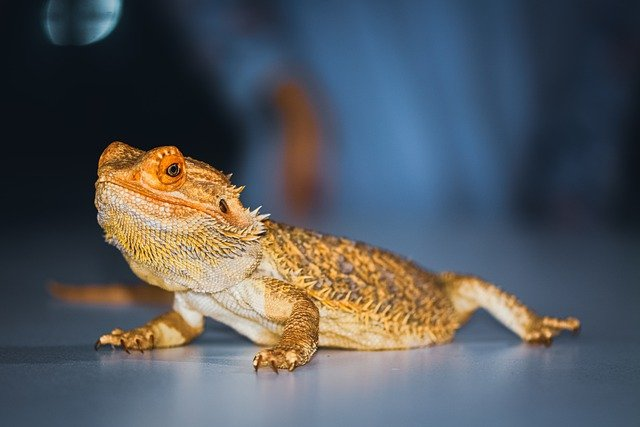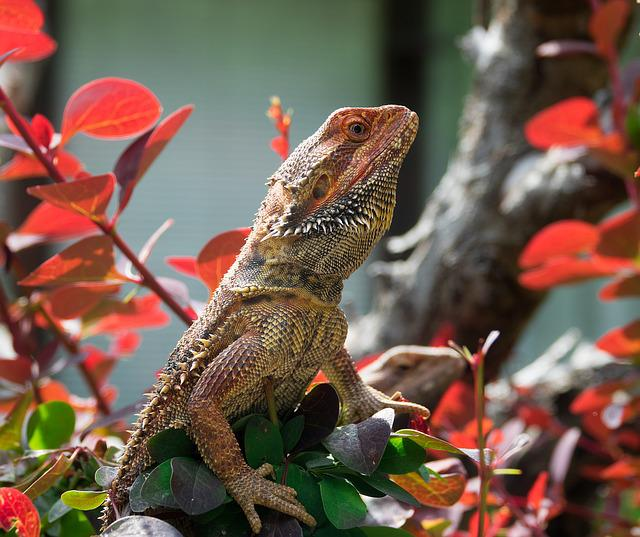Why is my bearded dragon turning yellow? If you’ve noticed that your bearded dragon is starting to turn yellow, you’re probably wondering why this is happening and what you can do about it. Don’t worry, you’re not alone! This is a common question that many bearded dragon owners have. In this blog post, we will discuss the possible causes of yellowing in bearded dragons and how you can correct it.

Bearded dragons are quite famous for their relatively low maintenance and can be easy to care for. They are usually light brown or greyish color. A yellow bearded dragon is a beautiful sight, but if your beardie is suddenly looking a little bit green, there might be something wrong. Some may turn jet black if they are angry or feel threatened.
Why Is My Bearded Dragon Turning Yellow?
One common issue that bearded dragon owners face is that their pets may start to turn yellow. There are a few reasons why this may happen. For example, it could be a sign of malnutrition, dehydration, or even part of its shedding process. It could also be a reaction to environmental changes or certain chemicals in the environment, such as chlorine or bleach. Other reasons are:
If your bearded dragon is getting improper UVB exposure, its color may start to fade. Additionally, if your bearded dragon’s tank does not have the appropriate accessories, its color may also start to change. In particular, bearded dragons need a basking area where they can soak up some UVB rays. Without this, your little guy’s color will start to fade and they may even develop health problems. So, if you’re wondering why your bearded dragon is turning yellow, it could be due to a lack of UVB exposure or the wrong tank setup.
Your animal is not getting enough hot water. Hot water is essential for bearded dragons, as it helps them to stay hydrated and digest their food properly. If your dragon isn’t getting enough, it could start to turn yellow. Another possibility is that the dragon is not getting enough vitamin D. Vitamin D is essential for bone growth and health, and a deficiency can cause several cases of health problems, including yellowing of the skin.
The yellow color is due to a lack of carotenoids in their diet. Carotenoids are a type of pigment that helps to give many reptiles their coloration. Without enough carotenoids, bearded dragons may start to turn pale yellow.
In the early stages, yellowing may be caused by a lack of food or water. If your reptile is not getting enough nutrients, it can lead to problems with the internal organs, which can cause the affected area to turn yellow. Yellowing can also be a sign of jaundice, which is a condition that affects the blood and causes the skin to turn yellow.
How To Prevent Yellow Fungus In Bearded Dragons?

Many bearded dragon owners notice their beloved pet turning a strange yellow color and wonder why. In most cases, the culprit is a fungus known as ‘Yellow Fungus’. While not dangerous to humans, this fungus can cause serious health problems for Bearded Dragons. The good news is that it is easy to treat yellow fungus and can be prevented with some simple precautions.
The first step in preventing yellow fungus in bearded dragons is to maintain clean and healthy environmental conditions. This means providing a clean tank or enclosure with fresh water and food. It’s also important to remove any debris or waste from the tank regularly especially since the yellow fungus is caused by a build-up of moisture on the skin and can be exacerbated by unclean tanks or learning to practice good husbandry. Tank accessories such as plants or hides can also harbor moisture and provide a perfect environment for the growth of yellow fungus. The best way to prevent yellow fungus spread is to maintain a clean and dry tank. Wash and disinfect your bearded dragon’s entire habitat daily with a sanitizer. Bearded dragon’s skin should be washed regularly with warm water and if you suspect your dragon is developing yellow fungus, take them to see a reptile vet as soon as possible. Left untreated, yellow fungus in bearded dragons can cause serious health problems and in severe cases inflammatory of the internal organs and bearded dragon’s kidneys. If you notice any signs of a yellow fungus disease, it’s important to take action immediately.
Can Poor Hygiene Breed Bearded Dragon’s Yellow Fungus?
If you’ve noticed your bearded dragon turning yellow, it’s important to take a look at its habitat and see if anything has changed recently. One common reason for this color change is due to a lack of basking spots. Bearded dragons rely on basking spots to raise their body temperature, so if there aren’t any available, they may start to turn yellow. Another possibility is that the tank accessories have changed color. If your pet is exposed to too much heat or light, the pigments in its skin may begin to break down, causing a yellow coloration. In addition, some Tank accessories can release toxins into the air that can be harmful to your bearded dragon.
Is Yellow Fungus Contagious?
If you notice your pet turning yellow, it’s important to check the Tank accessories to reduce the risk of reptile pathogen exposure which is dangerous. The most common way your dragon can contract the yellow fungus pathogen is by being around other bearded dragons infected with the yellow fungi. Yellowing and dull-looking scales can also be warning signs, so if you are concerned about your pet’s health, it’s always best to consult a reptile vet asap for a skin biopsy. Puss-like substance, stress marks, discolored scales, yellow fungus, irregular shedding, random troubling wounds are all signs of fungal infections or yellow fungus in bearded dragons.
Can Topical Antifungal Cream Cure The Yellow Skin Disease On My Infected Dragon?
The answer is yes, many bearded dragon owners have had good experiences with topical antifungal creams on their infected dragons, you can also use raw unpasteurized honey. Apply it to the affected area twice daily on the bearded dragon’s affected scales and dry skin. Betadine is a cream that will keep your infected dragon clean and will help eradicate the shedding fungus. Constant bathing will help the fungus spread even more.
Conclusion
If your bearded dragon is turning yellow, it could be a sign of a health problem. If you notice other changes in your pet’s behavior or appearance, make an appointment with your veterinarian. With prompt treatment, most health problems that cause yellowing can be resolved.

